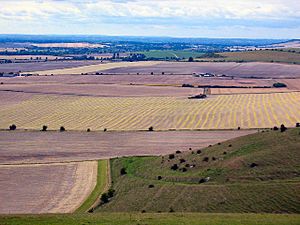Pewsey Downs facts for kids
Pewsey Downs is a special natural area in Wiltshire, England. It covers about 305 hectares (that's like 750 football fields!). This area is officially known as a Site of Special Scientific Interest (SSSI) because it has unique plants and animals. It was first recognized as important in 1951. Pewsey Downs is also home to the Pewsey Downs National Nature Reserve, which is an even more protected part of this amazing landscape.
Contents
What is Pewsey Downs?
Pewsey Downs is located on the southern edge of the North Wessex Downs, which are a range of hills. It's just north of the village of Pewsey. This area is mostly made up of chalk downland, which means it has rolling hills with grassy slopes that sit on chalky soil.
Why is it a Special Scientific Interest?
A Site of Special Scientific Interest (SSSI) is a place that the government protects because it has important wildlife, plants, or geology. Pewsey Downs is special because it has a unique type of grassland that supports many rare species. It's like a natural treasure chest!
Pewsey Downs National Nature Reserve
The Pewsey Downs National Nature Reserve is a very important part of Pewsey Downs. It's a large area of untouched chalk downland. This reserve sits on a steep slope above the Vale of Pewsey, which is a wide valley.
Hills and Landmarks
The reserve includes the south-facing slopes of three well-known hills:
You can also find the famous Alton Barnes White Horse carved into the hillside here. It's a giant horse shape made by removing grass to show the white chalk underneath!
Amazing Plants and Flowers
The main plants you'll see in the reserve are types of grass like sheep's fescue and red fescue. But what makes this place truly special are its rare wildflowers. These include:
- The early gentian
- The burnt-tip orchid
- The lesser butterfly orchid
- The frog orchid
These beautiful wildflowers provide food for many insects, especially butterflies.
Butterflies of the Reserve
Pewsey Downs is a fantastic place for butterflies. The many wildflowers offer the nectar they need to survive. Some of the rare and beautiful butterflies you might spot here include:
- The internationally rare marsh fritillary
- The adonis blue
- The chalkhill blue
These butterflies are an important part of the ecosystem and show how healthy this natural area is.


